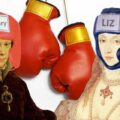
Elizabeth I’s Birth
Elizabeth I was born at around 3pm on the 7th September 1533 at Greenwich Palace. Her birth was straightforward and mother and baby were both healthy and strong, there was just one problem: Elizabeth was not the expected prince, she was another useless daughter.
Elizabeth had her mother’s coal black eyes and long nose, and her father’s Tudor red hair, and after the initial disappointment over her gender, her birth was celebrated, although in a much more low key way than had been planned, and a lavish christening was planned. Both of her parents were relieved that their daughter was healthy and had high hopes for a future son.
Elizabeth I’s Conception
Elizabeth’s mother, Queen Anne Boleyn, did not enter her confinement until the 26th August 1533, under 2 weeks before she gave birth, so it is likely that Elizabeth was slightly premature. A birthdate of the 7th September would mean that Elizabeth was conceived somewhere between the 11th and 19th December 1532, but it could have been later if Elizabeth was indeed early. A conception date in December would mean that Elizabeth was conceived out of wedlock as the secret marriage ceremony between her parents did not take place until the 25th January 1532. However, the chronicler Edward Hall wrote of how Henry VIII and Anne Boleyn were actually married on St Erkenwald’s Day 1532, the 14th November, just after they arrived back in England from their visit to France. Whatever the truth of the matter, we know that the couple were co-habiting after their return to England so it is likely that some kind of ceremony or betrothal took place around that time. Henry VIII had given Anne enough of a promise or commitment to make her finally relent and give him her virginity.
Elizabeth I’s Parents
Elizabeth I was the daughter of Henry VIII and his second wife, Queen Anne Boleyn.
 Anne Boleyn
Anne Boleyn
Anne Boleyn is often described as a commoner, but this just is not true. She was the daughter of a rising star at the English Court, diplomat Thomas Boleyn, and his wife, Elizabeth Howard, daughter of Thomas Howard, the 2nd Duke of Norfolk. Like all of Henry VIII’s wives, and Henry himself, Anne was descended from King Edward I, but she could actually trace her family back to him through both of her parents. Anne Boleyn had royal blood.
It is not known when she was actually born, some historians say 1501 and others say 1507 – see When Was Anne Boleyn Born?
There are many misconceptions about Anne Boleyn:-
- That she was a whore and homewrecker
- That she was deformed and had six fingers, a projecting tooth and a large wen, or growth, under her chin
- That she was a poisoner
- That she committed incest and adultery
- That she was a sexual predator and tease
etc. etc., you get the picture! See “Anne Boleyn – The Mysterious and Maligned One”
The real Anne Boleyn is a bit of an enigma, but it is certain that she was none of the above, although I don’t believe either that she was a Protestant martyr and that she single-handedly started the English Reformation. Whatever your thoughts on Anne Boleyn, she has gone down in history as being one of the two wives Henry VIII executed.
Henry VIII

- Jane Seymour – Jane died in October 1537 just a few days after giving birth to Elizabeth’s half-brother, Edward VI.
- Anne of Cleves – This marriage only lasted a few months as Henry found Anne unattractive and was unable to consummate the marriage with her.
- Catherine Howard – Catherine did not last long. Henry married her in July 1540 and she was executed for treason in February 1542 after it was found that she was not a virgin when she married the King and that she had been having a dangerous liaison with Henry’s groom, Thomas Culpeper. It is said that it was after Catherine’s execution that the young Elizabeth told her friend Robert Dudley that she would never marry.
- Catherine Parr – Catherine Parr is known for reconciling the King with his daughters and she had a close bond with Elizabeth. She outlived Henry VIII, dying in September 1548.
There are many different views on Henry VIII, with some seeing him as a great monarch and others seeing him as nothing more than a tyrannical monster. Eric Ives describes Henry VIII as “the ultimate unresolvable paradox of Tudor history” and he’s spot on, but whatever our thoughts on Henry VIII it is evident that Elizabeth I adored her father, she idolised him, so there must have been something in him to love and admire.
You can read more about Henry VIII in “Henry VIII – A Tyrant or just Misunderstood” and “Henry VIII: Renaissance Prince and King”.
Henry VIII and Anne Boleyn’s Marriage
Anne Boleyn married Henry VIII in January 1533 after a long courtship. David Starkey dates the start of their relationship back to Christmas and New Year 1524/5 and Eric Ives dates it back to Shrovetide 1526. Either way, it was a long courtship caused by the fact that the King was already married and needed to get an annulment. Henry VIII had been troubled that his marriage to his brother’s widow, Catherine of Aragon, was ‘cursed’ in that it was contrary to Biblical law. Leviticus 20 verse 21 said: “And if a man shall take his brother’s wife, it [is] an unclean thing: he hath uncovered his brother’s nakedness; they shall be childless.” Henry had convinced himself that Catherine had been unable to give him a surviving male heir because their marriage was not valid. In Holy Week 1533, a few months after Henry and Anne’s secret marriage, Catherine of Aragon was told that her marriage to Henry had been annulled and that she was now the Dowager Princess of Wales, Anne Boleyn was Queen.
Elizabeth I’s Siblings

Although Elizabeth was her mother’s first child, she actually had a half-sister from her father’s first marriage. This half sister had been the Princess Mary but her status was downgraded when her parents’ marriage was annulled in 1533. As a result of the marriage being annulled, and therefore deemed to have never existed, Mary was made illegitimate and she became known as the Lady Mary.
Mary was born on the 18th February 1516, making her 17 years old when Elizabeth was born. Her father ordered her to help care for Elizabeth in Elizabeth’s household but this, and her diminished status, did not prevent Mary from being very fond of her little sister in Elizabeth’s childhood.
When Elizabeth was four years old, her father’s third wife, Jane Seymour, gave birth to Prince Edward, the future Edward VI (1547-1553) who became King when he was just 9 years old. Edward grew up being close to both of his sisters, particularly Elizabeth as they were much closer in age, but before he died in July 1553, the boy king created a document “My Devise for the Succession” in which he removed his half-sisters from the succession and named the Protestant Lady Jane Grey as his successor. Lady Jane was queen for just 13 days as she was deposed on the 19th July by Edward’s half-sister, Mary, who was proclaimed Queen Mary I.
Mary reigned as queen from July 1553 until her death on the 17th November 1558. Although she and Elizabeth had had their difficulties, including Mary imprisoning Elizabeth in the Tower of London and also keeping her under house arrest, Elizabeth was named as her successor and became Queen. The rest, as they say, is history! Queen Elizabeth I reigned for over 44 years.
You can find out more about Elizabeth’s background in the following articles:-











Is there a link for Elizabeth’s other brother, Henry Fitzroy?
Very good and detailed article. However, it is true to say that Anne Boleyn is a commoner. She was a knight’s daughter and although of noble blood via her mother, Elizabeth Howard, sister to the Duke of Norfolk, her father Sir Thomas Boleyn was only enobled as a result of Anne’s rise to become Henry’s mistress, and later his Queen. As Lord Thomas Rochford, Earl of Wiltshire, he was raised to the noblility, but she is still a commoner. Not even her own enoblement to that of Marquis of Pembroke, makes her anything else but a commoner.
Why?
Commoner simply means someone who is not of royal blood or the royal family. It is only on her marriage to Henry on 25th January 1533, or rather her Coronation that she becomes Queen and so no longer a commoner.
Anne may not have been a home-wrecker or a whore, but she was the king’s mistress and she did set her sights at becoming Henry’s wife and replacing his lawful wife, Catherine of Aragon. As Henry was also still legally married to Catherine of Aragon in January 1533, and even, by the laws of the Catholic Church at the time of the birth of Elizabeth, then Henry committed bigamy. The Archbishop Cramner did not declare the marriage to Catherine null and void until end of May 1533, and the Holy Father did make a declaration on the marriage to Catherine until March 1534. The Pope, declared in favour of Catherine. Henry and Anne were committing bigamy and adultery! Elizabeth, by these laws and conditions was a bastard!
I would agree that Anne did not start the Protestant Reformation.
However, Henry’s split from Rome, although he remained a Catholic and introduced legislation to ensure the Catholic Church was the formal faith of his England; opened the door to the reformation.
Cromwell ensured that reformed practices found there way into the churches and tried to reverse the Catholic faith by destroying the monastic houses and some of the feast days. He did a lot more but this is not the place.
Cramner, helped Anne to appoint Bishops and clergy helpful to the reformers cause and many reformers joined her household. She also promoted the Tyndale Bible and allowed it to be read, even though it was not officially adopted. Cromwell rose under her reign, even though she disagreed with him. However, she was not a Lutheran or a Protestant, she merely had reformer tendencies. She went to Mass the same as everyone else and she was horrified at the selling of monastic land. She wanted to reform the monasteries, not to destroy them.
I also agree that she did not have many of the deformities that she was said to have. But she cannot be cleared of every charge against her. I have never believed that she committed sexual adultery or that she committed incest with her brother George and Phillippa Gregory in her book The Other Boleyn Girl has some imagination.
But she did make threats to poison Mary and Catherine and I am not convinced that given the chance she would not have done. Catherine, unfortunately died of cancer and so we cannot say for sure if she was also poisoned. There is also a question mark over whether or not she acted inappropriately with Mark Smeaton, although giving gifts for services to servants was a common thing; and she may even have wished Henry dead. She had a fiery temper and a loose tongue. Goodness knows what she may have said had she had too much to drink!
The proof is only speculative, but it is now explored in a book by Bernard. He is not the only one to ask if she was guilty and the evidence was extensive. 100 pages of accusations! I am not convinced she did anything that you could call treason, but Cromwell seems to have had enough dirt on her to have condemned her a dozen times over. He was told to get rid of her; well he certainly did that.
Cromwell also had some sort of loyalty to Katherine of Aragon and felt sorry for her. He also expressed some concern and sympathy for Mary. He quickly jumped ship and anchored himself to Jane Seymour. In fact the only one to defend poor Anne was Thomas Cramner in a letter to Henry VIII.
But there is one fact that is in my mind: Elizabeth was conceived out of wedlock and born as the product of a bigamous and illegal marriage. She should never have come to the throne! But then again, by the same standards; neither should William the Bastard; also born out of wedlock!
I
You say “Commoner simply means someone who is not of royal blood or the royal family” and so therefore Anne was a commoner, but that is precisely my argument, Anne did have royal blood and, in fact, had more royal blood than her husband. Through her mother and the Howard family, Anne could trace her roots back to Edward I, but she could also do it through her father’s Butler ancestry – see http://www.theanneboleynfiles.com/anne-boleyns-royal-blood/5967/
I have read G W Bernard’s book and found it interesting but not convincing, lots of “might have”s. He is certainly not the only one to wonder if Anne was guilty but he does not provide any new evidence to support her guilt and there is far more evidence to support her innocence, particularly as the Crown could not even be bothered to make sure that the dates in the indictments made any sense whatsoever. Bernard and Ives have been arguing the point for decades now, but Ives’ conclusions make much more sense when related to the primary sources.
Anne did have a very loose tongue and a very fiery temper, but there is a big difference between saying something and doing it. Anne Boleyn was not charged with poisoning anyone or even attempting to poison anyone. We all say stupid things in the heat of the moment when we are under pressure and just because Anne wished them dead it does not mean that she would have condoned murder.
I completely agree with you on religion. Anne Boleyn had reformist views but she wanted to reform the Catholic Church, not start a whole new church. She died a Catholic, not a Protestant.
Listen to u guys telling each other what Anne did and didn’t do- said and didn’t say- meant and didn’t mean! Like u would know- NO1 REALLY knows how Anne was! She’s been dead over 600 years! And the only accounts of her we have are tainted & bias! Either by people who loved her or people who hated her (Chapuise).. No objective account so there! U don’t know how she was or what she didn’t do or did do… LOL
There may be bias in primary sources but you can compare primary sources and look for the similarities between them and that is how you work out what happened and what people were really like. That is how historians do their jobs and hypothesise.
Annomonus’ statement just proves that the myths about Anne Boelyn still prevails and there are those who speak without knowledge. Anne did not die over 600 years ago and there is enough factual, contemprary evidence for the knowledgable historian or layperson to make educated assumptions. Much of Anne’s life is shrounded in mist and mystery but enough can stand in the sun to show she was an amazing woman for her time, well educated, religious, and ambitious. Although attitudes about educating women had changed and she had received more education than most women of her day, she was still expected to be the subservient, closed mouth wife who followed her husband’s direction completely. That she was out spoken and capable of forming her own opinons as well as expressing them would not have put in good standing with any man at court, especially her husband who was known to be a King who insisted that everyone follow his commands and would not hesitate to take revenge on those who did not agree with him. Anne’s faith was sealed when she miscarried a son; the one sin Henry could never forgive.